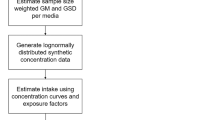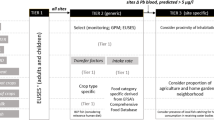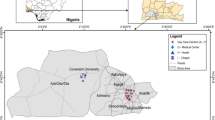Abstract
Polybrominated diphenyl ethers (PBDEs) are a class of brominated flame retardants added to plastics, polyurethane foam, electronics, textiles, and other products. These products release PBDEs into the indoor and outdoor environment, thus causing human exposure through food and dust. This study models PBDE dose distributions from ingestion of food for Irish adults on congener basis by using two probabilistic and one semi-deterministic method. One of the probabilistic methods was newly developed and is based on summary statistics of food consumption combined with a model generating realistic daily energy supply from food. Median (intermediate) doses of total PBDEs are in the range of 0.4–0.6 ng/kgbw/day for Irish adults. The 97.5th percentiles of total PBDE doses lie in a range of 1.7–2.2 ng/kgbw/day, which is comparable to doses derived for Belgian and Dutch adults. BDE-47 and BDE-99 were identified as the congeners contributing most to estimated intakes, accounting for more than half of the total doses. The most influential food groups contributing to this intake are lean fish and salmon which together account for about 22–25% of the total doses.
This is a preview of subscription content, access via your institution
Access options
Subscribe to this journal
Receive 6 print issues and online access
$259.00 per year
only $43.17 per issue
Buy this article
- Purchase on Springer Link
- Instant access to full article PDF
Prices may be subject to local taxes which are calculated during checkout

Similar content being viewed by others
References
Acheson K.J., Campbell I.T., Edholm O.G., Miller D.S., and Stock M.J. The measurement of food and energy-intake in man — an evaluation of some techniques. Am J Clin Nutr 1980: 33 (5): 1147–1154.
Akutsu K., Takatori S., Nakazawa H., Hayakawa K., Izumi S., and Makino T. Dietary intake estimations of polybrominated diphenyl ethers (PBDEs) based on a total diet study in Osaka, Japan. Food Addit Contam Part B Surveill 2008a: 1 (1): 58–68.
Akutsu K., Takatori S., Nozawa S., Yoshiike M., Nakazawa H., and Hayakawa K., et al Polybrominated diphenyl ethers in human serum and sperm quality. Bull Environ Contam Toxicol 2008b: 80 (4): 345–350.
Bakker M.I., De Winter-Sorkina R, De Mul A., Boon P.E., Van Donkersgoed G., and Van Klaveren J.D., et al. Dietary intake and risk evaluation of polybrominated diphenyl ethers in The Netherlands. Mol Nutr Food Res 2008: 52 (2): 204–216.
Birnbaum L.S., and Staskal D.F. Brominated flame retardants: cause for concern? Environ Health Perspect 2004: 112 (1): 9–17.
Birnbaum L.S., and Hubal E.A.C. Polybrominated diphenyl ethers: a case study for using biomonitoring data to address risk assessment questions. Environ Health Perspect 2006: 114 (11): 1770–1775.
Bocio A., Llobet J.M., Domingo J.L., Corbella J., Teixido A., and Casas C. Polybrominated diphenyl ethers (PBDEs) in foodstuffs: human exposure through the diet. J Agric Food Chem 2003: 51 (10): 3191–3195.
BSEF. Fact sheet — brominated flame retardant deca-BDE, decabromodiphenyl ether. www.bsef.com, 2009 Accessed on 27 March 2009.
Chan W., McCance R.A., Buss D.H., and Brown J. Miscellaneous Foods: Fourth Supplement to the Fifth Edition of McCance and Widdowson's The Composition of Foods. Royal Society of Chemistry and Ministry of Agriculture, Fisheries and Food, Cambridge, 1994.
Chan W., and McCance R.A. Meat Poultry and Game: Fifth Supplement to the Fifth Edition of McCance and Widdowson's The composition of foods. Royal Society of Chemistry and Ministry of Agriculture, Fisheries and Food, Cambridge, 1995.
Chan W., and McCance R.A. Meat Products and Dishes: Sixth Supplement to the Fifth Edition of McCance and Widdowson's The Composition of Foods. Royal Society of Chemistry and Ministry of Agriculture, Fisheries and Food, Cambridge, 1996.
Chao H.R., Wang S.L., Lee W.J., Wang Y.F., and Papke O. Levels of polybrominated diphenyl ethers (PBDEs) in breast milk from central Taiwan and their relation to infant birth outcome and maternal menstruation effects. Environ Int 2007: 33 (2): 239–245.
Creme Ltd. CREMe Software 2.0: The Tower Trinity Technology and Enterprise Campus. Grand Canal Quay Dublin 2, Ireland, 2009.
Cullen A.C., and Frey H.C. Probabilistic Techniques in Exposure Assessment a Handbook for Dealing with Variability and Uncertainty in Models and Inputs. Plenum Press, New York (etc.), 1999.
Darnerud P.O. Brominated flame retardants as possible endocrine disrupters. Int J Androl 2008: 31 (2): 152–160.
De Wit C.A. An overview of brominated flame retardants in the environment. Chemosphere 2002: 46 (5): 583–624.
Dodd K.W., Guenther P.M., Freedman L.S., Subar A.F., Kipnis V., and Midthune D., et al. Statistical methods for estimating usual intake of nutrients and foods: a review of the theory. J Am Diet Assoc 2006: 106 (10): 1640–1650.
European Commission DIRECTIVE 2003/11/EC OF THE EUROPEAN PARLIAMENT AND OF THE COUNCIL of 6 February 2003 amending for the 24th time Council Directive 76/769/EEC relating to restrictions on the marketing and use of certain dangerous substances and preparations (pentabromodiphenyl ether, octabromodiphenyl ether). Official Journal of the European Union 2003, 2.
Fernandes A.R., Tlustos C., Smith F., Carr M., Petch R., and Rose M. Polybrominated diphenylethers (PBDEs) and brominated dioxins (PBDD/Fs) in Irish food of animal origin. Food Addit Contam Part B Surveill 2009: 2 (1): 86–94.
Fraser A.J., Webster T.F., and McClean M.D. Diet contributes significantly to the body burden of PBDEs in the general US population. Environ Health Perspect 2009: 117 (10): 1520–1525.
Friel S., Kelleher C.C., Nolan G., and Harrington J. Social diversity of Irish adults nutritional intake. Eur J Clin Nutr 2003: 57 (7): 865–875.
Gomara B., Herrero L., Bordajandi L.R., and Gonzalez M.J. Quantitative analysis of polybrominated diphenyl ethers in adipose tissue, human serum and foodstuff samples by gas chromatography with ion trap tandem mass spectrometry and isotope dilution. Rapid Commun Mass Spectrom 2006: 20 (2): 69–74.
Harrad S., Wijesekera R., Hunter S., Halliwell C., and Baker R. Preliminary assessment of UK human dietary and inhalation exposure to polybrominated diphenyl ethers. Environ Sci Technol 2004: 38 (8): 2345–2350.
Harrad S., and Diamond M. New directions: exposure to polybrominated diphenyl ethers (PBDEs) and polychlorinated biphenyls (PCBs): current and future scenarios. Atmos Environ 2006: 40 (6): 1187–1188.
Harrad S., Ibarra C., Abdallah M.A.E., Boon R., Neels H., and Covaci A. Concentrations of brominated flame retardants in dust from United Kingdom cars, homes, and offices: causes of variability and implications for human exposure. Environ Int 2008: 34 (8): 1170–1175.
He J.Z., Robrock K.R., and Alvarez-Cohen L. Microbial reductive debromination of polybrominated diphenyl ethers (PBDEs). Environ Sci Technol 2006: 40 (14): 4429–4434.
Health Canada. Nutrient Value of Some Common Foods. Minister of Health, Ottawa, 2008.
Hoffmann K., Boeing H., Dufour A., Volatier J.L., Telman J., and Virtanen M., et al. Estimating the distribution of usual dietary intake by short-term measurements. Eur J Clin Nutr 2002: 56: S53–S62.
Holland B., Unwin I.D., Buss D.H., McCance R.A., and Widdowson E.M. McCance and Widdowson's the Composition of Foods. 4th Supplement, Milk Products and Eggs, 4th [rev. & ext.] edn Royal Society of Chemistry and Ministry of Agriculture, Fisheries and Food; HMSO, London, 1989.
Irish Universities Nutrition Alliance (IUNA). North/South Ireland Food Consumption Survey: Food And Nutrient Intakes, Anthropometry, Attitudinal Data & Physical Activity Patterns. Food Safety Promotion Board, Dublin, 2001.
IUNA. North/South Ireland Food Consumption Survey: Food And Nutrient Intakes, Anthropometry, Attitudinal Data & Physical Activity Patterns. Food Safety Promotion Board, Dublin, 2001.
Johnson-Restrepo B., and Kannan K. An assessment of sources and pathways of human exposure to polybrominated diphenyl ethers in the United States. Chemosphere 2009: 76 (4): 542–548.
Jones-Otazo H.A., Clarke J.P., Diamond M.L., Archbold J.A., Ferguson G., and Harner T., et al. Is house dust the missing exposure pathway for PBDEs? An analysis of the urban fate and human exposure to PBDEs. Environ Sci Technol 2005: 39 (14): 5121–5130.
Kierkegaard A., Asplund L., De Wit C.A., McLachlan M.S., Thomas G.O., and Sweetman A.J., et al. Fate of higher brominated PBDEs in lactating cows. Environ Sci Technol 2007: 41 (2): 417–423.
La Guardia M.J., Hale R.C., and Harvey E. Detailed polybrominated diphenyl ether (PBDE) congener composition of the widely used penta-, octa-, and deca-PBDE technical flame-retardant mixtures. Environ Sci Technol 2006: 40 (20): 6247–6254.
Lorber M Exposure of Americans to polybrominated diphenyl ethers. J Expo Sci Environ Epidemiol 2008: 18 (1): 2–19.
Main K.M., Kiviranta H., Virtanen H.E., Sundqvist E., Tuomisto J.T., and Tuomisto J., et al. Flame retardants in placenta and breast milk and cryptorchidism in newborn boys. Environ Health Perspect 2007: 115 (10): 1519–1526.
McDonald T.A. A perspective on the potential health risks of PBDEs. Chemosphere 2002: 46 (5): 745–755.
McNamara C., Naddy B., Rohan D., and Sexton J. Design, development and validation of software for modelling dietary exposure to food chemicals and nutrients. Food Addit Contam 2003: 20: S8–S26.
Meeker J.D., Johnson P.I., Camann D., and Hauser R. Polybrominated diphenyl ether (PBDE) concentrations in house dust are related to hormone levels in men. Sci Total Environ 2009: 407 (10): 3425–3429.
Moser G.A., and McLachlan M.S. The influence of dietary concentration on the absorption and excretion of persistent lipophilic organic pollutants in the human intestinal tract. Chemosphere 2001: 45 (2): 201–211.
Oracle. How Crystal Ball calculates sensitivity. http://download.oracle.com/docs/cd/E12825_01/epm.111/cb_user/frameset.htm?ch01s04.html, 2009a Accessed on 20 October 2009.
Oracle. Crystal Ball. http://www.oracle.com/crystalball/index.html, 2009b Accessed on 20 October 2009.
Schecter A., Haffner D., Colacino J., Patel K., Papke O., and Opel M., et al. Polybromianted diphenyl Ethers (PBDEs) and hexabromocyclodecane (HBCD) in composite US food samples. Environ Health Perspect 2010: 118 (3): 6.
Schenker U., Soltermann F., Scheringer M., and Hungerbuhler K. Modeling the environmental fate of polybrominated diphenyl ethers (PBDEs): the importance of photolysis for the formation of lighter PBDEs. Environ Sci Technol 2008: 42 (24): 9244–9249.
Scheringer M., Vögl T., von Grote J., Capaul B., Schubert R., and Hungerbuhler K. Scenario-based risk assessment of multi-use chemicals: application to solvents. Risk Anal 2001: 21 (3): 481–497.
Sioen I., Bilau M., Verdonck F., Verbeke W., Willems J.L., and De Henauw S., et al. Probabilistic intake assessment of polybrominated diphenyl ethers and omega-3 fatty acids through fish consumption. Mol Nutr Food Res 2008: 52 (2): 250–257.
Slob W Probabilistic dietary exposure assessment taking into account variability in both amount and frequency of consumption. Food Chem Toxicol 2006: 44 (7): 933–951.
Stapleton H.M., Alaee M., Letcher R.J., and Baker J.E. Debromination of the flame retardant decabromodiphenyl ether by juvenile carp (Cyprinus carpio) following dietary exposure. Environ Sci Technol 2004: 38 (1): 112–119.
Stapleton H.M., Kelly S.M., Allen J.G., Mcclean M.D., and Webster T.F. Measurement of polyhrominated diphenyl ethers on hand wipes: estimating exposure from hand-to-mouth contact. Environ Sci Technol 2008: 42 (9): 3329–3334.
Tlustos C., Pratt I., McHugh B., Tyrrell L., Cooper H., and Duffy C., et al. Investigation into levels of polybrominated diphenyl ethers (PBDEs) and hexabromocyclododecane diastereomers (HCBD) in fishery produce available on the Irish market. Organohal Comp 2005: 67: 634–639.
Tooze J.A., Midthune D., Dodd K.W., Freedman L.S., Krebs-Smith S.M., and Subar A.F., et al. A new statistical method for estimating the usual intake of episodically consumed foods with application to their distribution. J Am Diet Assoc 2006: 106 (10): 1575–1587.
Trudel D., Horowitz L., Wormuth M., Scheringer M., Cousins I.T., and Hungerbuhler K. Estimating consumer exposure to PFOS and PFOA. Risk Anal 2008: 28 (2): 251–269.
Turyk M.E., Persky V.W., Imm P., Knobeloch L., Chatterton R., and Anderson H.A. Hormone disruption by PBDEs in adult male sport fish consumers. Environ Health Perspect 2008: 116 (12): 1635–1641.
UKFSA. Brominated chemicals in farmed and wild fish and shellfish and fish oil dietary supplements, 2006a.
UKFSA. Brominated chemicals: UK dietary intakes — Food Survey Information Sheet 10/06, 2006b.
USEPA. DecaBDE phase-out initiative. http://www.epa.gov/oppt/existingchemicals/pubs/actionplans/deccadbe.html, 2009 Accessed on 13 April 2010.
Van den Steen E., Covaci A., Jaspers V.L.B., Dauwe T., Voorspoels S., and Eens M., et al. Accumulation, tissue-specific distribution and debromination of decabromodiphenyl ether (BDE 209) in European starlings (Sturnus vulgaris). Environ Pollut 2007: 148 (2): 648–653.
Van der Ven L.T., Van De Kuil T., Leonards P.E., Slob W., Canton R.F., and Germer S., et al. A 28-day oral dose toxicity study in Wistar rats enhanced to detect endocrine effects of decabromodiphenyl ether (decaBDE). Toxicol Lett 2008: 179 (1): 6–14.
Viberg H., Fredriksson A., Jakobsson E., Orn U., and Eriksson P. Neurobehavioral derangements in adult mice receiving decabrominated diphenyl ether (PBDE 209) during a defined period of neonatal brain development. Toxicol Sci 2003: 76 (1): 112–120.
Voorspoels S., Covaci A., Neels H., and Schepens P. Dietary PBDE intake: a market-basket study in Belgium. Environ Int 2007: 33 (1): 93–97.
Wormuth M., Scheringer M., Vollenweider M., and Hungerbuhler K. What are the sources of exposure to eight frequently used phthalic acid esters in Europeans? Risk Anal 2006: 26 (3): 803–824.
Acknowledgements
We thank Beat Brüschweiler, Lukas Tlustos, two anonymous reviewers and Christine F. Chaisson for helpful comments, and Harald von Waldow for providing the computer infrastructure to run the EBM models. We also thank Tobias Rotzler for programming a tool to perform ROS on a large number of data sets. This work was primarily funded by the Swiss Federal Office of Public Health.
Author information
Authors and Affiliations
Corresponding author
Additional information
Supplementary Information accompanies the paper on the Journal of Exposure Science and Environmental Epidemiology website
Supplementary information
Rights and permissions
About this article
Cite this article
Trudel, D., Tlustos, C., Von Goetz, N. et al. PBDE exposure from food in Ireland: optimising data exploitation in probabilistic exposure modelling. J Expo Sci Environ Epidemiol 21, 565–575 (2011). https://doi.org/10.1038/jes.2010.41
Received:
Accepted:
Published:
Issue Date:
DOI: https://doi.org/10.1038/jes.2010.41
Keywords
This article is cited by
-
Maternal transfer of environmentally relevant polybrominated diphenyl ethers (PBDEs) produces a diabetic phenotype and disrupts glucoregulatory hormones and hepatic endocannabinoids in adult mouse female offspring
Scientific Reports (2020)
-
Human exposure to PBDE and critical evaluation of health hazards
Archives of Toxicology (2015)



